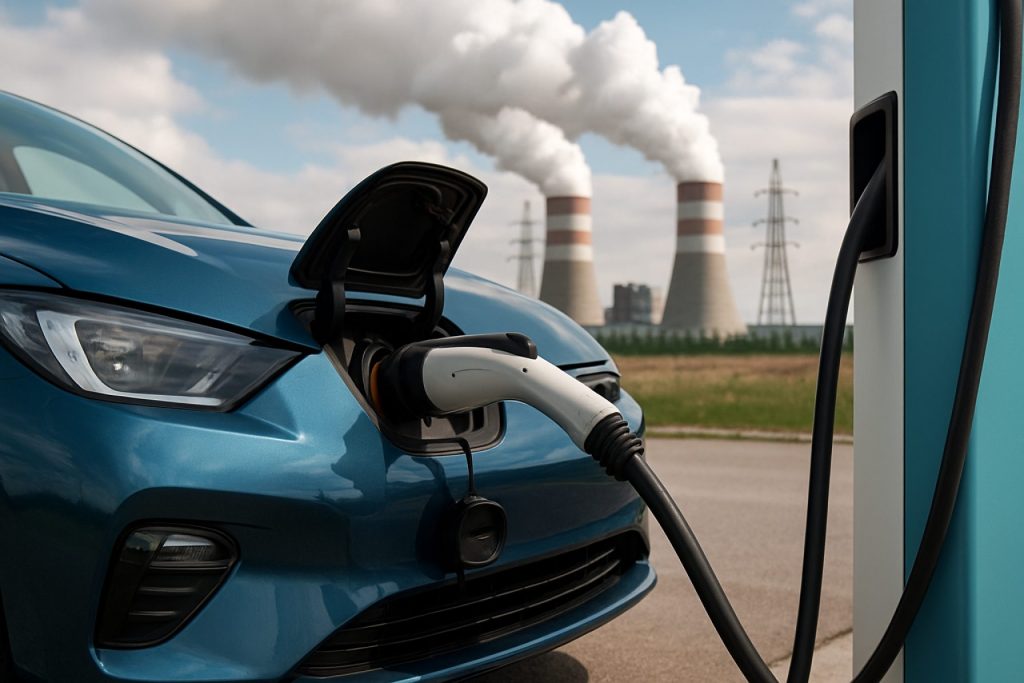
- The electric vehicle (EV) charging market is experiencing rapid global growth, projected at a 36.5% CAGR from 2025 to 2032.
- Governments and private companies are investing heavily in charging infrastructure, driving innovation and expansion.
- Europe leads in EV adoption and charging station deployment, with supportive regulations, funding, and public enthusiasm for clean technology.
- North America is accelerating EV infrastructure through strategic policies and partnerships with major industry players like Tesla.
- Fast-charging stations and smart, connected chargers are making EV use more convenient for urban and long-distance drivers.
- Challenges such as high installation costs, power grid limitations, and varied connector standards remain.
- The growth of EV charging creates opportunities for innovation, sustainability, and new business models worldwide.
Vivid neon signs flicker along Europe’s highways, illuminating sleek electric vehicles as they dock at cutting-edge charging hubs—evidence of a market hurtling toward an electrified new era. In bustling cities from Oslo to Berlin, commuters peel away from curbside chargers, no longer tethered by range anxiety. This is not a distant dreamy vision—it’s the new normal unfolding, energized by innovation, policy, and a surge of unprecedented investment.
The momentum is staggering. In the blink of an economic cycle, the worldwide electric vehicle (EV) charging stations market is set to soar at a remarkable 36.5% compound annual growth rate from 2025 through 2032. The landscape is transforming as governments and private companies jockey to reshape how we fuel our lives. The implications stretch far beyond city streets—they reach into boardrooms, power grids, and the very air we breathe.
Rapid Urbanization, Faster Charging
Gone are the days when overnight home charging was a novelty. Today, residents in urban centers plug into Level II AC chargers—dependable, affordable, and swift. Still, the real excitement ignites around new fast-charging stations popping up near cafés, shopping centers, and expressways. These high-voltage direct current (DC) chargers can replenish a battery in minutes, not hours, emancipating drivers from the tyranny of long waits and opening the roads to seamless cross-country journeys.
Europe: Where Innovation and Legislation Merge
On the global stage, Europe seizes the crown. With countries like Norway boasting over 80% EV penetration, the continent’s streets hum with electric life. Progressive emission standards, generous government funding, and a public appetite for green technology have forged an environment where charging stations are as familiar as corner stores. Germany and the Netherlands follow suit, pouring resources into infrastructure and pushing the needle on clean mobility.
America’s New Gold Rush
Not to be outdone, North America is racing to catch up. The United States, powered by the Bipartisan Infrastructure Law and innovative juggernauts such as Tesla and General Electric, is laying down a network of charging corridors from coast to coast. Strategic collaborations, tech innovation, and state-level mandates are converging to ignite an EV boom, backed by billions in public and private investment.
Behind the Curtain: The Forces at Play
Bold government policies drive demand, backed by a mandate to cut carbon emissions. Automakers funnel billions into R&D—developing faster, smarter chargers that can communicate, guide, and even accept a tap-to-pay. Solar panels pop up beside charging stations, hinting at a future where vehicles refuel on sunshine, not fossil fuels. Meanwhile, vehicle-to-grid technology offers a tantalizing vision—cars not just as transportation, but as mobile batteries supporting the grid during surges.
Yet, challenges persist. Installing fast chargers demands heavy investment and technical muscle, especially where power grids buckle under strain. Connector standards remain a maze of acronyms—CHAdeMO, CCS—sowing confusion and discouraging use among new adopters. In areas where EVs remain rare, uncertainty and slow ROI temper the rush.
The Next Charge: Opportunity Sparks Across the Globe
Imagination and entrepreneurship thrive where difficulties arise. Mobile charging vans swoop in to rescue stranded drivers. Smart city platforms layer data atop every outlet—balancing supply, streamlining payments, integrating with urban planning. Asia-Pacific and Latin America, eager adopters of digital innovations, stand at the cusp of exponential EV growth.
Key Takeaway: The electric vehicle charging revolution is accelerating—with speed, scale, and imagination. For consumers, it means more convenience and cleaner air. For investors and innovators, it represents a high-voltage opportunity that rewards vision and resilience. The real question isn’t whether the world will go electric—but how quickly, and which players will lead the charge.
Discover more about the evolving landscape of mobility and sustainability at Tesla or follow the global energy conversation at Europe.eu.
10 Surprising New Trends in the Global EV Charging Revolution That Will Change How You Drive
# Electric Vehicle Charging Stations 2024: Unseen Insights, Growth Trends, and Smart Strategies You Need to Know
The electric vehicle (EV) charging market is not only transforming how we fuel up—but also how we live, innovate, and invest. With technological leaps, supportive policies, and surging demand, the sector is accelerating faster than almost any other. Here are the essential, little-known facts and actionable insights every driver, investor, and policymaker needs to know.
—
Deeper Dive: What You Need to Know About EV Charging Stations
1. Technical Evolution: From kW to Gb Per Second
– Ultra-fast chargers: Modern stations, especially in Europe, deliver up to 350 kW, replenishing 100 km of range in just 5–10 minutes (source: IEA).
– Smart Grid Integration: Many charging systems now directly communicate with the electrical grid, enabling dynamic load balancing and off-peak charging—crucial for grid stability in high-EV regions.
2. Connector Confusion and Standardization Wars
– Multiple Charger Types: CHAdeMO, CCS (Combined Charging System), Tesla Supercharger, and GB/T (in China) compete globally. Lack of a single universal standard often frustrates early adopters.
– How-To Hack: Always check your EV’s compatibility with station connectors on route planners before a trip.
3. Real-World Use Cases Expanding Fast
– Fleet Solutions: Delivery giants (like Amazon) are investing in dedicated depot charging, optimizing charging algorithms for non-stop logistics.
– Home Energy Ecosystems: New residential charging systems double as backup power, especially when paired with home solar and battery storage.
4. Policy and Incentives: What’s Working?
– Europe ([europa.eu](https://europa.eu)): Mandates minimum charger distances on highways (every 60 km in EU by 2026), spurring rapid infrastructure rollout.
– USA: Tax credits (up to $7,500 for new EVs, capped for high-income buyers) are boosting demand.
5. Market Forecasts & Industry Trends
– Exponential Growth: IDC predicts over 70 million public and private chargers worldwide by 2030.
– Superchargers Outpacing Homes: In high-density cities, fast public charging is projected to surpass home charging by 2027.
6. Security and Sustainability Concerns
– Cyber Threats: As chargers become connected, vulnerabilities to ransomware and data theft increase. Manufacturers are responding with encrypted communications and firmware updates.
– Green Power: Some networks, like Ionity and Tesla, already promise 100% renewable-sourced electricity.
7. Reviews & Comparisons
| Feature | Level 2 (AC) Charger | DC Fast Charger |
|————————|—————————-|—————————|
| Speed | 2–8 hours (full charge) | 15–45 min (80% charge) |
| Cost per kWh | $0.10–$0.30 | $0.25–$0.65 |
| Typical Location | Home, parking lots | Highways, malls |
| Upfront Cost | $400–$2,000 | $10,000–$100,000+ |
8. Pros and Cons Overview
– PROS: Clean air, reduced running costs, home charging convenience, incentives, cutting-edge tech.
– CONS: High upfront costs, early infrastructure patchiness, connector confusion, potential for urban charging congestion.
9. Emerging Controversies & Limitations
– Grid Strain: In peak periods, charging multiple vehicles can overload older grids (especially during summer/winter surges).
– Rural Rollout: Investment is lagging outside urban hot spots, slowing mass EV adoption in remote communities.
– Raw Materials: Lithium and cobalt mining for batteries has sustainability and ethical concerns.
10. Life Hacks & How-To Steps
– Route Planning Apps: Use apps like PlugShare, Electromaps, or Google Maps to find real-time station status and connector types.
– Charge Timing: Charge during off-peak electricity hours (often midnight–6 am) for lower rates and greener energy.
– Loyalty Programs: Many networks (Tesla, ChargePoint) offer discounts or bonus credits for frequent charging.
—
Top 5 Pressing Reader Questions—Answered!
1. Will there be enough chargers for EV growth by 2030?
– Yes, but urban-rural and regional disparities will persist. Europe and China lead; the US is rapidly catching up.
2. Is it safe to leave my car at a charger overnight?
– In most cases, yes—modern chargers have multiple safety protocols. Use secure, well-lit stations whenever possible.
3. Can EVs charge at any station?
– Not always. Check compatibility and bring an adapter when traveling outside your home region.
4. Do all chargers use green energy?
– Not universally. Some networks, like [Tesla](https://www.tesla.com) Superchargers in Europe, guarantee renewable energy sourcing. Check provider details.
5. Is fast-charging bad for EV batteries?
– Regular use of fast chargers can slightly shorten battery lifespan versus slower charging—but modern battery management systems reduce this effect.
—
Actionable Recommendations & Quick Tips
– Test local fast-charging stations—even if you mostly charge at home. The experience may save you in a pinch.
– Sign up for updates from your local utility or charging network to snag incentives or beta-test new features.
– Push for local policy adoption using proven case studies from [Europe](https://europa.eu) to accelerate clean mobility in your community.
– Consider future-proof chargers compatible with multiple connector standards and smart home energy integration.
– Invest in smart EV chargers if renting out properties; it’s becoming a sought-after amenity.
—
For authoritative, up-to-date insights, monitor [Tesla](https://www.tesla.com) for innovations and [Europe](https://europa.eu) for policy shifts. Embrace the electrified future—it’s closer, faster, and more sustainable than you think!



